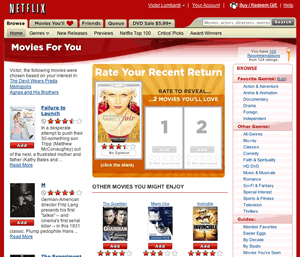I’m developing a new course, Introduction to Internet Business Strategy, that I’m pretty excited about. Ironically, though everyone in the Internet industry discusses strategy, it’s difficult to find any standard references on the topic. This presents a great opportunity for me to plunge in and synthesize the basics as well as to examine what role design has played so far.
 One company I’m reverse engineering is Netflix. The store-less video subscription service claims to be “the world’s largest online movie rental service, providing more than 6.3 million subscribers access to more than 70,000 DVD titles.” They have an impressive physical presence too: “Netflix operates 42 shipping centers located throughout the United States… On average, Netflix ships 1.575 million DVDs each day.” And though they compete against giant Blockbuster as well as smaller chains and neighborhood shops as well as video-on-demand services, earnings have doubled each year the past three years.
One company I’m reverse engineering is Netflix. The store-less video subscription service claims to be “the world’s largest online movie rental service, providing more than 6.3 million subscribers access to more than 70,000 DVD titles.” They have an impressive physical presence too: “Netflix operates 42 shipping centers located throughout the United States… On average, Netflix ships 1.575 million DVDs each day.” And though they compete against giant Blockbuster as well as smaller chains and neighborhood shops as well as video-on-demand services, earnings have doubled each year the past three years.
So how do they do it?
If you ask analysts or the business press, they’ll point to first-mover advantage: Netflix established a firm base of subscribers long before Blockbuster woke up and realized what had happened. Since then, both Blockbuster and Wal-Mart launched similar services and then, suffering lackluster sales, backed off.
How was upstart Netflix fending off Blockbuster or Wal-Mart with their expansive physical presence and established customer base?
In the language of Michael Porter, Netflix’s strategic advantage – at least initially – was differentiation: they delivered and charged for movies differently than Blockbuster. But when considering the long-term (in this case, just a few years) Netflix needed to ask, “will this strategy hold up over time?†The answer was no. Of course Blockbuster and others had the capability and the cash to copy Netflix’s operations.
Having quickly dominated the market, Netflix needed superior customer retention to compete against bigger competitors that could undercut them on price. Netflix needed something new to further differentiate its service and defend its advantage (the other main startegy — focusing on a niche — wasn’t an option because Netflix needed to operate on a national scale given their large established assets and small margins). So Netflix invested in design to further differentiate their service, in particular using a method intended to retain customers: personalization. Personalization strengthens the relationship between the business and customer in two ways. One, by offering already understood features like recommendations, Netflix gives customers smarter service than competitors. As I write this, the entire Netflix member home page is personalized DVD recommendations, and Karl Long has argued that the sheer volume of user ratings has become a strategic resource. Second, by learning about the customer over time Netflix can use this business intelligence to steer operating decisions.
For Netflix, personalization (or any large undertaking) is very expensive to implement. For designers and information architects, justifying it isn’t just a matter of conducting user research and discovering that users would like a feature like recommendations. Justifying a large capital expense such as this has to align with the strategy to be both cost effective and a competitive advantage, as it was in the case of Netflix.
Comments
3 responses to “Netflix’s Competitive Advantage”
[…] Sometimes someone writes about the Netflix personalised recommendation service. […]
[…] Netflix’s Competitive Advantage [Noise Between Stations] […]
How can we avail of your course? and how much does it cost?